Breaking News: Massive Policy Change for First-Time Home Buyers
30-Year Mortgages & $1.5-million Purchases
Every so often the federal government makes a massive policy change to influence Canada’s real-estate market.
In 2017, the government brought in the stress-test. This essentially threw a wet-blanket on a hot real-estate market. It helped end runaway housing prices, and it worked – until 2020.
Today, the federal government released a massive change to CMHC’s mortgage policies in an attempt to help first-time home buyers.
New Policy Coming December 16th, 2024.
CMHC is expanding the maximum amortization on their insured mortgage product for First-Time Home Buyers from 25-years to 30-years. Additionally, they will increase the maximum purchase price for these mortgages to $1.5-million.
Increasing the amortization from 25-years to 30-years will help improve affordability by lowering the mortgage payment by $49/m for every $100,000 borrowed.
A $500,000 mortgage with a 25-yr amortization @ 4.50% has a monthly payment of $2,767/m. Increasing the amortization to 30-years lowers the payment to $2,521/m. A difference of $246/m.
Increasing the amortization will increase first-time home buyers’ purchasing power.
Let’s look at an example:
Average BC Household Income: $100,000
Down-Payment: $50,000
Interest Rate: 4.50%
Current Max Purchase Price: $476,000
Max Purchase Price (New Rules): $506,000
Increased Purchasing Power: +$30,000
Key Take Aways
The lower the household income is, the less effect these policy changes will have on one’s purchasing power:
Annual Income: $60,000
- Increased Purchasing Power: +$16,000
Annual Income: $80,000
- Increased Purchase Power: +$22,000
Annual Income: $100,000
- Increased Purchasing Power: +$30,000
Annual Income: $150,000
- Increased Purchasing Power: +$52,000
Annual Income: $200,000
- Increased Purchasing Power: +$64,000
These policy changes are a direct result of slow sales, rising inventory and falling house prices in certain parts of the country. The government is attempting to kick-start the real-estate market by allowing first-time homebuyers to increase their purchasing power without changing the stress-test.
I believe this change will motivate many first-time homebuyers to jump into the housing market. However, there is a risk this policy could do the opposite and increase home prices
It seems to me, allowing 30-year mortgages and increasing first-time home buyers’ purchasing power, the government is inadvertently setting a “floor” on housing prices.
Upcoming POTENTIAL CHANGES
OSFI has been relatively quiet lately. In April, there was talks of OSFI creating a stress-test 2.0 limiting uninsured mortgages to 4.5x Loan-to-Income at the big 5 banks. I believe we will receive an update to this policy within the next 4 weeks.

